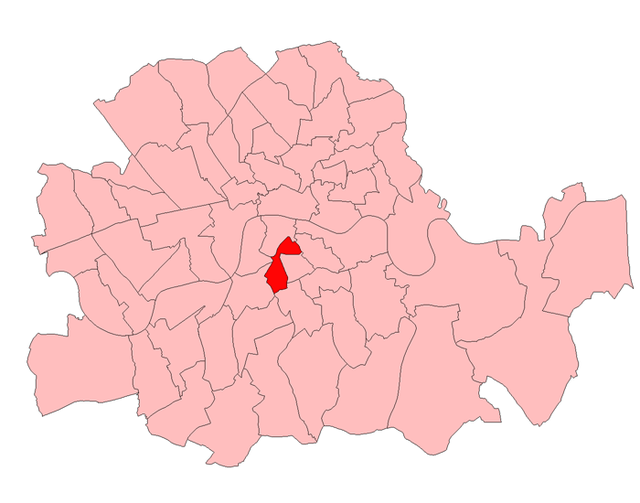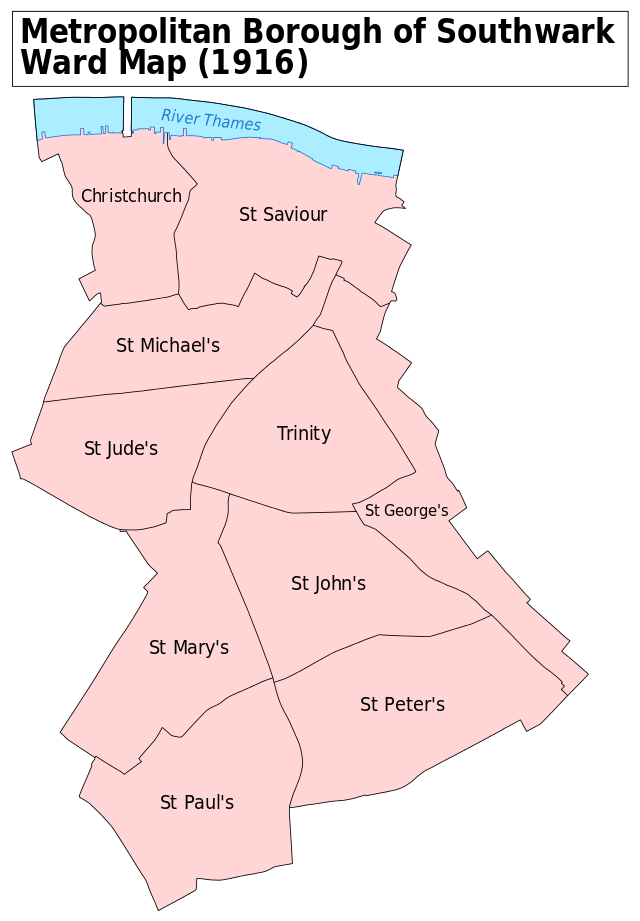Southwark Central (UK Parliament constituency)
Parliamentary constituency in the United Kingdom, 1918–1950 From Wikipedia, the free encyclopedia
Southwark (Br [ˈsʌðɨk])[1] Central was a borough constituency returning a single Member of Parliament to the House of Commons of the Parliament of the United Kingdom through the first past the post voting system. The constituency was a very compact and urban area, and was one of three divisions of the Parliamentary Borough of Southwark, which was identical to the Metropolitan Borough of Southwark, in South London. The creation of the constituency was recommended by the Boundary Commission in a report issued in 1917, and formally created by the Representation of the People Act 1918. It came into existence at the 1918 general election.

| Southwark Central | |
|---|---|
| Former borough constituency for the House of Commons | |
| 1918–1950 | |
| Seats | one |
| Created from | Newington West |
| Replaced by | Southwark |
As the borough of Southwark had only 67,279 electors on 15 October 1946, the relevant date for the subsequent Boundary Commission review, the borough was only entitled to a single Member of Parliament. As a consequence Southwark Central was abolished as a separate constituency by the Representation of the People Act 1948, along with its neighbours Southwark North and Southwark South East and went out of existence at the 1950 general election, forming part of the re-established Southwark constituency.
Boundaries
Summarize
Perspective

When the constituency was created, it was defined to include three whole wards of the Metropolitan Borough of Southwark (St Mary's, St Paul's and Trinity) together with a small section of the St George's ward. This formed an area in two main parts linked by a narrow strip of land around Elephant and Castle. The southern section, between Kennington Park Road and Walworth Road, including the St Mary and St Paul wards, was almost entirely residential. It stretched to Kennington Park and to Avenue Road, being the southern boundary of the borough. Around the Elephant and Castle area the constituency included Newington Butts and the Metropolitan Tabernacle, but at its narrowest point it was only about 100 yards between the western boundary on Newington Causeway and the eastern boundary on the railway line through Elephant & Castle railway station.
North of Elephant and Castle, the constituency turned to the east and included a second area of Newington between New Kent Road and Newington Causeway in the Trinity ward. The southern boundary of this part of the constituency continued along New Kent Road to divide St George's ward along it and Tower Bridge Road up to the borough boundary with Bermondsey. The northern part of Trinity ward, north of Wickham Place, was not included.[2] The constituency's last MP, future Chancellor Roy Jenkins, described it as "postage stamp-sized".[3]
Members of Parliament
| Election | Member | Party | |
|---|---|---|---|
| 1918 | James Daniel Gilbert | Coalition Liberal | |
| 1922 | National Liberal | ||
| 1923 | Liberal | ||
| 1924 | Harry Day | Labour | |
| 1931 | Ian Horobin | National | |
| 1935 | Harry Day | Labour | |
| 1940 by-election | John Hanbury Martin | Labour | |
| 1948 by-election | Roy Jenkins | Labour | |
| 1950 | constituency abolished: see Southwark | ||
Elections
Elections in the 1910s
| Party | Candidate | Votes | % | ±% | |
|---|---|---|---|---|---|
| C | Liberal | James Daniel Gilbert | 8,060 | 72.1 | |
| Labour | Leslie Haden-Guest | 3,126 | 27.9 | ||
| Majority | 4,934 | 44.2 | |||
| Turnout | 11,186 | ||||
| Liberal win (new seat) | |||||
| C indicates candidate endorsed by the coalition government. | |||||
Elections in the 1920s
| Party | Candidate | Votes | % | ±% | |
|---|---|---|---|---|---|
| National Liberal | James Daniel Gilbert | 10,522 | 65.6 | −6.5 | |
| Labour | George Dobson Bell | 5,522 | 34.4 | +6.5 | |
| Majority | 5,000 | 31.2 | −13.0 | ||
| Turnout | 16,044 | ||||
| National Liberal hold | Swing | ||||
| Party | Candidate | Votes | % | ±% | |
|---|---|---|---|---|---|
| Liberal | James Daniel Gilbert | 8,676 | 45.3 | −20.3 | |
| Labour | Harry Day | 6,690 | 34.9 | +0.5 | |
| Unionist | Charles Louis Nordon | 3,801 | 19.8 | New | |
| Majority | 1,986 | 10.4 | −20.8 | ||
| Turnout | 21,167 | ||||
| Liberal hold | Swing | -10.4 | |||
| Party | Candidate | Votes | % | ±% | |
|---|---|---|---|---|---|
| Labour | Harry Day | 9,199 | 40.0 | +5.1 | |
| Liberal | James Daniel Gilbert | 7,817 | 34.1 | −11.2 | |
| Conservative | Charles Louis Nordon | 5,937 | 25.9 | +6.1 | |
| Majority | 1,382 | 5.9 | N/A | ||
| Turnout | 22,953 | ||||
| Labour gain from Liberal | Swing | ||||
| Party | Candidate | Votes | % | ±% | |
|---|---|---|---|---|---|
| Labour | Harry Day | 13,318 | 52.3 | +12.3 | |
| Unionist | Edward Keeling | 6,256 | 24.6 | −1.3 | |
| Liberal | James Robert Want | 5,878 | 23.1 | −11.0 | |
| Majority | 7,062 | 27.7 | +21.8 | ||
| Turnout | 25,452 | ||||
| Labour hold | Swing | +6.8 | |||
Elections in the 1930s
| Party | Candidate | Votes | % | ±% | |
|---|---|---|---|---|---|
| National | Ian Horobin | 15,913 | 65.3 | New | |
| Labour | Harry Day | 8,466 | 34.7 | −17.6 | |
| Majority | 7,447 | 30.6 | N/A | ||
| Turnout | 24,379 | ||||
| National gain from Labour | Swing | ||||
| Party | Candidate | Votes | % | ±% | |
|---|---|---|---|---|---|
| Labour | Harry Day | 11,098 | 53.3 | +18.6 | |
| National Labour | Ernest Stanford | 9,735 | 46.7 | New | |
| Majority | 1,363 | 6.6 | N/A | ||
| Turnout | 20,833 | ||||
| Labour gain from National | Swing | ||||
Elections in the 1940s
| Party | Candidate | Votes | % | ±% | |
|---|---|---|---|---|---|
| Labour | John Hanbury Martin | 5,285 | 64.3 | +11.0 | |
| Anti-War | Charles W. Searson | 1,550 | 18.9 | New | |
| National | Violet Van der Elst | 1,382 | 16.8 | New | |
| Majority | 3,735 | 45.4 | +38.8 | ||
| Turnout | 8,217 | ||||
| Labour hold | Swing | ||||
| Party | Candidate | Votes | % | ±% | |
|---|---|---|---|---|---|
| Labour | John Hanbury Martin | 9,336 | 71.9 | +18.6 | |
| Conservative | William Steward | 3,654 | 28.1 | New | |
| Majority | 5,682 | 43.8 | +37.2 | ||
| Turnout | 12,990 | ||||
| Labour hold | Swing | ||||
| Party | Candidate | Votes | % | ±% | |
|---|---|---|---|---|---|
| Labour | Roy Jenkins | 8,744 | 65.4 | −6.5 | |
| Conservative | James Greenwood (MP) | 4,623 | 34.6 | +6.5 | |
| Majority | 4,121 | 30.8 | −13.0 | ||
| Turnout | 13,367 | ||||
| Labour hold | Swing | ||||
References
Sources
Wikiwand - on
Seamless Wikipedia browsing. On steroids.
